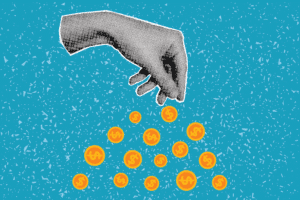
Typically triggered by a failed Community Reinvestment Act exam or a pending merger, community benefits agreements channel billions towards affordable housing, job training and down payment assistance programs. iStock illustration
TD Bank recently announced it was planning to spend $20 billion on a community benefit plan aimed at helping low- to moderate-income and minority communities in its territories, including Boston. It’s not the first multi-billion-dollar community investment plan Massachusetts has seen from a bank, but how are these big plans crafted, and where exactly do these funds go?
Multi-billion-dollar community commitments such as TD Bank’s are bred from community benefits agreements with the National Community Reinvestment Coalition (NCRC) and nonprofit organizations. As of January 2024, NCRC lists $600 billion worth of commitments made by American banks as part of community benefits agreements the group negotiated, including TD Bank’s.
These deals are triggered in two scenarios: during an upcoming bank merger, or if a bank has failed a Community Reinvestment Act (CRA) exam. In TD Bank’s case, it has consistently ranked “outstanding” in CRA exams, the highest rating possible.
“I think these conversations with the NCRC started when the TD Bank and First Horizon Bank merger was announced. Often, NCRC engages with banks like TD that are merging with other big banks,” Tom Callahan, executive director of the Boston-based Partnership for Financial Equity, said. “That deal didn’t go forward but TD stayed at the negotiating table with NCRC, which they deserve some credit for.”
In February 2022, TD Bank announced it would acquire First Horizon Bank but the merger fell through in May 2023 after being unable to get regulatory approvals after more than a year.
Banks with local presence have also penned multi-year agreements with the NCRC, such as M&T Bank (a $43 billion plan) when it announced its merger with People’s United Bank, and First Citizens Bank (a $16 billion plan) when it acquired the failed Silicon Valley Bank.
Banks as ‘Good Neighbors’
Callahan said that banks know the importance of being viewed as a “good corporate citizen and partner,” whether they use that for acquiring more banks in the future, or purely because they believe that lending to low- and moderate-income and minority communities is good business and can tackle persistent wealth gaps.
“Case in point: Eastern Bank, with their slogan ‘Join Us For Good,’ investing in small businesses in Lawrence and elevating some of its CRA investments is quite extraordinary, and we’d love to see more and more banks take that approach,” Callahan said. “People will be drawn to start to do business or continue to do business with a bank that invests in low-income communities because they’re perceived as a good neighbor.”
Michael Innis-Thompson, head of community lending and development at TD Bank, said that the bank’s $20 billion community investment plan is an affirmation of its support to the low- and moderate-income (LMI) and minority communities in the 15 states the bank operates in, including Massachusetts.
“We have an existing special purpose credit program for mortgages and we will be developing one more for small business [lending]. [The plan] is recognizing that there is an imbalance and racial disparities,” Innis-Thompson said. “For example, the homeownership rate for non-Hispanic whites is [at] approximately 74 percent versus the 44 percent for Blacks. You have a huge gap there, so this commitment is intended to focus on that in the five cities that we focus on and throughout our footprint.”
He said the plan doesn’t specify how the funds will be spread among the bank’s different objectives, but rather is needs- or demands-based across all the communities it serves, resulting in incremental lending to communities. The $20 billion amount was determined after listening sessions with NCRC and nonprofit organizations across its branch footprint, as well as looking at data from government agencies such as the U.S. Department of Housing and Urban Development and the Small Business Administration.
Being perceived as a “good neighbor” also helps smooth merger deals.
With the resumption of bank merger activity possible this year after a slow 2023, Callahan said that it would not be surprising if TD Bank were to announce a new merger in the next year.
TD Bank’s Innis-Thompson denied that while its community benefits plan started with the First Horizon deal, it went forward without a link to any other merger transaction.
“The previously announced Community Benefits Plan was contingent on our transaction with First Horizon. We felt strongly that it’s the right thing to do to craft a commitment that will have a similar economic impact in the 15 states and Washington, D.C., where we currently operate. The Community Impact Plan is the result of this work and is not for any transaction,” he said.
When contacted for an interview, an NCRC spokesperson pointed to the advocacy group’s website, which says community benefits agreements are a way for banks to spell out for regulators and the public, in writing, how they will satisfy CRA requirements when they merge with a bank, and how they will execute and increase lending, investments and philanthropy for underserved borrowers and neighborhoods. Community benefits agreement negotiations can range in length from four months to two years.
The coalition pushes banks to increase community development loans and investments (CDLI) during community benefits agreement negotiations as many banking institutions “have fallen behind in reaching appropriate CDLI levels” due to “relaxed enforcement of CRA rules.”
Agreements’ Impact Channeled
Past community investment plans from CBAs have supported initiatives through community development corporations and other nonprofits. In Massachusetts, some of the usual entities that are given funds to distribute to beneficiaries through programs include the quasi-public Massachusetts Housing Partnership (MHP) housing finance agency for residential lending, down payment assistance and housing developments projects, the nonprofit Massachusetts Affordable Housing Alliance for down payment assistance and the Massachusetts Association of Community Development Corporations (MACDC) for small business and other community investment programs.
Since the inception of its ONE Mortgage program in 1990, MHP, program has helped over 24,000 low to moderate-income first-time homebuyers, 60 percent of whom are from households of color, according to data posted on MHP’s website. The ONE Mortgage program helps first-time homebuyers buy with down payments as low as 3 percent, take out mortgages at lower interest rates, qualify for higher mortgage loan amounts and lower credit score requirements on those loans.

Nika Cataldo
MHP also reported that since its creation in 2022, its new down payment assistance program MassDREAMS has funded grants for 290 households as of June 2023, 76 percent of which included people of color and 61 percent had incomes below 80 percent of area median income.
According to NCRC data, more than 50 percent of CBA funds go to direct mortgage and small business lending to the banks’ communities, while the rest are divided into community development loans and investments, the building of branches in LMI and minority areas which also serve as centers and hubs for community events, as well as other philanthropic activities.
Outside of residential lending, MACDC is one of the major beneficiaries of these community investment plans, and funds distributed through its members provide for small business lending and counseling, building and restoring affordable housing projects and job training.
MACDC’s annual report says its members invested over $1.6 billion in local communities in 2023, and benefited 84,265 families and 1,846 small businesses. More than $1 billion of that spending by community development corporations went to real estate projects and housing assistance, while $600 million went to various community programs.
MACDC members also put $20.5 million into loans and grants to small businesses; created and preserved 6,100 jobs; constructed and renovated affordable multifamily and apartment buildings; provided training, skills and continuing education programs, financial literacy workshops and many others.




 |
| 
